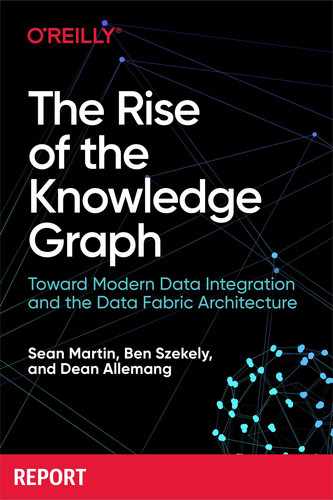Businesses manage data to understand the connections between their customers, products or services, features, markets, and anything else that affects the business. With a knowledge graph, you can represent these connections directly to analyze and understand the compound relationships that drive business innovation. This report introduces knowledge graphs and examines their ability to weave business data and business knowledge into an architecture known as a
data fabric
.
Authors Sean Martin, Ben Szekely, and Dean Allemang explain graph data and knowledge representation and demonstrate the value of combining these two things in a knowledge graph. You'll learn how knowledge graphs enable an enterprise-scale data fabric and discover what to expect in the near future as this technology evolves. This report also examines the evolution of databases, data integration, and data analysis to help you understand how the industry reached this point.
Table of Contents
- The Rise of the Knowledge Graph
- Executive Summary
- Introduction
- Emergence of the Knowledge Graph
- Semantic Systems
- Data Representation
- Bringing It Together: The Need for the Knowledge Graph
- Data and Graphs: A Quick Introduction
- Why Graphs Are Cool
- Graph Data Use Cases
- Advantages of Graph Standardization
- Technology Independence
- Publishing and Subscribing to Graph Data
- Standardizing Graphs: The Resource Description Framework
- Future-Proofing Your Data
- Querying Graphs: SPARQL
- The Knowledge Layer
- What Is a Vocabulary?
- Managing Vocabularies in an Enterprise
- What Is an Ontology?
- Ontology Versus Data Model
- Ontology and Representation
- Why Knowledge Is Cool
- Knowledge Use Cases
- Standardizing Knowledge Representation
- Standardizing Vocabulary: SKOS
- Standardizing Concepts: RDFS
- Representing Data and Knowledge in Graphs: The Knowledge Graph
- Classes and Instances
- Digging Deeper into the Knowledge Graph
- Why Knowledge Graphs Are Cool
- Knowledge Graph Use Cases
- The Network Effect of the Knowledge Graph
- Beyond Knowledge Graphs: An Integrated Data Enterprise
- Data Architecture Failure Modes
- Knowledge Graph Technology for a Data Fabric
- Getting Started on Building Your Data Fabric
- Motivation for a Data Fabric
- Timing of the Data Fabric
- References
